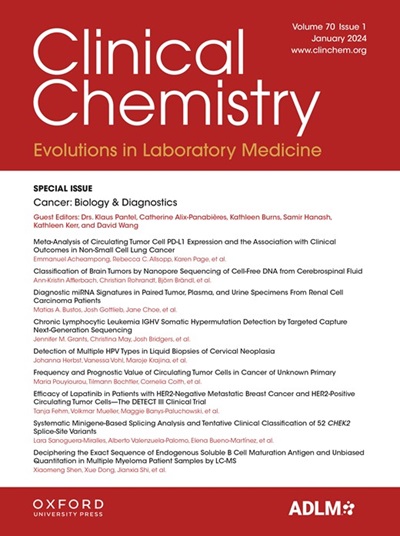B-277 Detectable Levels of Toxic Metals in Children's Playgrounds
IF 7.1
2区 医学
Q1 MEDICAL LABORATORY TECHNOLOGY
引用次数: 0
Abstract
Background Metal-contaminated soil poses significant health risks to kids because they are more sensitive to heavy metal exposure in the environment. Studies have shown that continuous exposure to metals can increase the risk of metal accumulation in blood and various body organs. This study determines the levels of some toxic metals in various playgrounds in our community. Methods We determined the levels of lead (Pb), chromium (Cr), cadmium (Cd), and copper (Cu) in six playgrounds (parks) (T-RP, T-GP, T-TX, L-HH, L-WH, L-SPLX) using graphite furnace atomic absorption spectrophotometry (GF-AAS) technique. Soil samples were collected at least one foot below the soil surface, and metal was extracted using ultra-pure nitric before analysis using GF-AAS. Data were analyzed using analysis of variance (ANOVA). Results The results showed significant detectable levels of the metals in all playgrounds evaluated in this study. L-WH Park in League City has the highest detectable levels of Pb (12.43 ± 46 mg/Kg, P<0.05) compared to other children playgrounds examined in this study (T-RP (3.93 ± 3.97 mg/Kg), T-GP (7.09 ± 2.79 mg/Kg), T-TX (6.05 ± 1.92 mg/Kg), L-HH (4.68 ± 0.76 mg/Kg), L-SPLX (2.64 ± 1.63 mg/Kg). The concentration of detectable cadmium in T-RP park (0.16 ± 0.11 mg/Kg) was significantly higher than all the other five children's playgrounds studied L-WH (0.02 ± 0.01 ), T-GP (0.05 ± 0.04 mg/Kg), T-TX (0.02 ± 0.01 mg/Kg), L-HH (0.04 ± 0.01 mg/Kg), L-SPLX (0.09 ± 0.04 mg/Kg) (P<0.05). Conclusions The playgrounds contain detectable toxic metals that might pose health risks to children in the community. Though the lead levels are below the CDC-recommended lead soil concentration in urban areas, they still pose health risks to children in the environment when continuously exposed to the playground. The concentrations of Cu and Cr were not statistically different among the playgrounds. The detection of Pb and Cd highlights the potential health risks to children. Overall, this study shows that metal levels in playgrounds should be public information available to parents.B-277 儿童游乐场中可检测到的有毒金属含量
背景 受金属污染的土壤对儿童的健康构成重大风险,因为他们对环境中的重金属暴露更为敏感。研究表明,持续接触金属会增加金属在血液和身体各器官中积累的风险。本研究确定了我们社区各种游乐场中一些有毒金属的含量。方法 我们利用石墨炉原子吸收分光光度法(GF-AAS)测定六个游乐场(公园)(T-RP、T-GP、T-TX、L-HH、L-WH、L-SPLX)的铅(Pb)、铬(Cr)、镉(Cd)和铜(Cu)含量。土壤样本在土壤表层下至少一英尺处采集,使用超纯硝酸提取金属,然后使用 GF-AAS 进行分析。数据采用方差分析法进行分析。结果表明,在本研究评估的所有游乐场中,可检测到明显的金属含量。与本研究中检测的其他儿童游乐场(T-RP(3.93 ± 3.97 mg/Kg)、T-GP(7.09 ± 2.79 mg/Kg)、T-TX(6.05 ± 1.92 mg/Kg)、L-HH(4.68 ± 0.76 mg/Kg)、L-SPLX(2.64 ± 1.63 mg/Kg)相比,联盟市 L-WH 公园的铅检测水平最高(12.43 ± 46 mg/Kg,P<0.05)。T-RP 公园的镉检测浓度(0.16 ± 0.11 毫克/千克)明显高于其他五个儿童游乐场:L-WH(0.02 ± 0.01 )、T-GP(0.05 ± 0.04 毫克/千克)、T-TX(0.02 ± 0.01 毫克/千克)、L-HH(0.04 ± 0.01 毫克/千克)、L-SPLX(0.09 ± 0.04 毫克/千克)(P<0.05)。结论 游乐场含有可检测到的有毒金属,可能会对社区儿童的健康造成危害。虽然铅含量低于疾病预防控制中心建议的城市地区土壤铅浓度,但如果儿童持续暴露在游乐场中,仍会对环境中的儿童健康造成危害。各游乐场的铜和铬浓度在统计上没有差异。铅和镉的检测结果凸显了对儿童健康的潜在风险。总之,这项研究表明,游乐场中的金属含量应作为公共信息提供给家长。
本文章由计算机程序翻译,如有差异,请以英文原文为准。
求助全文
约1分钟内获得全文
求助全文
来源期刊

Clinical chemistry
医学-医学实验技术
CiteScore
11.30
自引率
4.30%
发文量
212
审稿时长
1.7 months
期刊介绍:
Clinical Chemistry is a peer-reviewed scientific journal that is the premier publication for the science and practice of clinical laboratory medicine. It was established in 1955 and is associated with the Association for Diagnostics & Laboratory Medicine (ADLM).
The journal focuses on laboratory diagnosis and management of patients, and has expanded to include other clinical laboratory disciplines such as genomics, hematology, microbiology, and toxicology. It also publishes articles relevant to clinical specialties including cardiology, endocrinology, gastroenterology, genetics, immunology, infectious diseases, maternal-fetal medicine, neurology, nutrition, oncology, and pediatrics.
In addition to original research, editorials, and reviews, Clinical Chemistry features recurring sections such as clinical case studies, perspectives, podcasts, and Q&A articles. It has the highest impact factor among journals of clinical chemistry, laboratory medicine, pathology, analytical chemistry, transfusion medicine, and clinical microbiology.
The journal is indexed in databases such as MEDLINE and Web of Science.
 求助内容:
求助内容: 应助结果提醒方式:
应助结果提醒方式:


